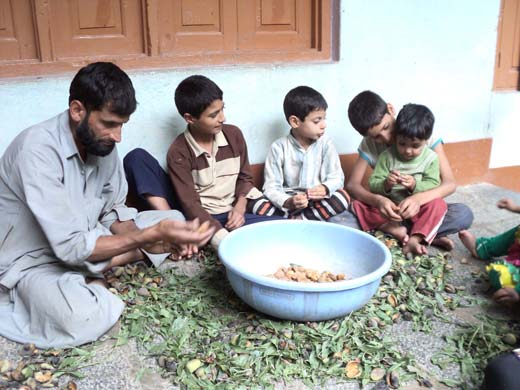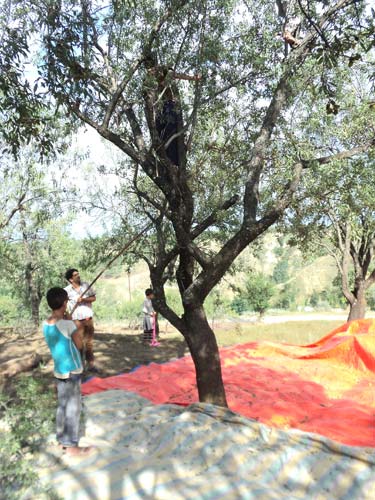While Kashmiri almond growers fail to market their produce for want of knowledge and government support, Jammu despite not producing even a single almond dominate the dry fruit market in the state, Riyaz Ul Khaliq reports.

It was a kind of revelation for Suresh Kumar, a Mumbai based tourist who was on a week-long trip to Kashmir with his family, that almonds are actually produced in Kashmir valley and not Jammu. The notion that almonds are produced in Jammu instead of Kashmir has its roots in business monopoly that traders of Jammu have maintained over the years.
Ironically, despite being the largest producer of almonds and other dry fruits in India, there is no centralized market or Mandi in Kashmir. Entire business is being carried by Jammu based traders. “Jammu does not produce even a single dry fruit yet Narwal Mandi controls entire business,” said a Kashmir based almond trader who wishes not to be named.
However the trend is changing now. New age farmers from Kashmir are now selling their produce in mainland India directly. But the ‘monopoly’ of the trade lies with Jammuites. “Almost entire dry fruit market is hijacked by Jammu based traders,” informs a dry fruit dealer wishing not to be identified.
G M Rather who has served Horticulture department as Area Marketing Officer says that the visitors from other Indian states think that almonds are produced in Jammu and not Kashmir. “It is nothing but shocking,” he says.
“As dry fruit business is dominated by Jammu based traders tourists feel almonds are cheaper in Jammu than in Kashmir,” Rather tells Kashmir Life.
Production Woes
Muhammad Amin is busy with plucking, cleaning, drying and packaging of almonds nowadays. The Karewa land on the hilltops in the lap of Chrar-i-Sharief is abuzz with activity. Amin owns almost 20 kanals of this Karewa. He is using this piece of land for two crops: almonds and saffron. The practice is called dual farming in the Horticulture diction. Amin who inherited this orchid from his father does not remember when these trees were planted. “The trees have been planted by my father,” Amin tells Kashmir Life while collecting almonds from the traupalin under an almond tree. “The production is going down now,” he says, adding, “The age factor is certain.”
The process of almond production is no different from other horticulture crops of Kashmir. In early March, farmers add fertilizers to their fields and start watering them and by the end of the month, almond flowers are out.
After that, between March and August, Amin keep an eye over the fields. He routinely adds fertilsers, water, if available, and prays for a sunny summer.
“July heat is important but over heating is detrimental,” Amin says. “Water is necessary but the climate is playing spoilsport now.” Amin complains that the almonds farms don’t get water at proper time. He blames the horticulture department of turning blind eye to their problems. The farmers, it seems, are in desperate need of water hand pumps in these areas.
He says though water is important but clouds and rain after their due time is very detrimental for the crop. He prays that the downpour or hail storms miss his almond fields during this time of year.
Come August, Amin and company (his family) cancel their engagements, if any, to get to fields and start plucking almonds.
During off season Amin works at his stone quarry in Pantha chowk, on the outskirts of Srinagar City. The next step is packing. “We pack almonds from different trees separately because of the quality, color and size,” says Amin. The quality differs from one tree to another.
Amin says he and his extended family usually work themselves in the fields and at home. “We don’t employ outside labourers for this job,” says Amin.
The next step is to clean the green almonds plucked from the trees. “A five kilograms green almonds bag produces just 2 to 3 kilograms of finished almonds after cleaning,” says Amin.
After the green covering is removed manually the almonds are again left to dry in the sun. “Color quality of almonds depend on the amount of sunshine they receive,” claims Amin. It is said that too much of exposure can change almond color to black which finds no takers in market. “People like to buy clean almonds with no spots,” says Amin. After the dying process is over almonds are finally ready for marketing.
At this stage ‘middle man’ enters the process. “We rarely take our production to market ourselves, otherwise the dealers come to our homes for the collection,” Amin’s brother Pupa told Kashmir Life.
M S Teli who is a Horticulture expert with National Bank of Agriculture and Rural Development (NABARD) says that though the production of almonds in Kashmir is not high but the quality is good.
“The farmers of the almond orchards were made aware about the dual farming and many are practicing it,” he says in a chat, at his office in Fruit Mandi Parim Pora, with Kashmir Life. The dual farming adds to the economy of J&K state in general.
Presentation Matters
 “Farmers are not packaging and presentation conscious. People associated with the process do not make their product presentable, they add different sizes of almonds to a single pack,” says Teli. “The size is nature dependable.”
“Farmers are not packaging and presentation conscious. People associated with the process do not make their product presentable, they add different sizes of almonds to a single pack,” says Teli. “The size is nature dependable.”
Farooq Ahmad who deals with fresh as well as dry fruits says that only 20% of the total produce of almonds is worth eating while the rest is used for oil and other purposes.
Farooq adds that California produce is very good at first sight. “The size and color of almonds from USA is very attractive and that is why the buyers prefer them,” he says. Farooq puts blame on farmers at first and then dealers for low quality of almonds. “People mix different varieties and sell them in market. Not only this, they add Apricot seeds to almonds which is nothing but dishonesty.”
“The packaging is very important, people of the trade should pack different sizes in different packs,” Teli suggests.
Commenting on the low produce of almonds, Teli informs that the trees have out grown and people now prefer apple orchards to almonds. “Apple fetches more money to farmers and the trade is within their reach.”
Teli says the step motherly treatment of Horticulture department makes the crop suffer. He suggests farmers to take their queries to SKUAST-K who are responsible for the solutions to their problems.
But the scientists at Central Institute of Temperate Horticulture have, “Developed new techniques for rejuvenating the ageing almond trees.”
The recent reports by CITH suggest the productivity of almonds “is very low as compared to that in the advanced countries due to old and decayed orchard, poor or no canopy management, no irrigation and fertilization etc.”
“We thought if we cut the old trees and plant new ones it will consume lot of time and it will result in socio-economic problems,” one of the scientists at CITH, K.K Srivastava have said.
The team of scientists at CITH led by its Director Nazeer Ahmad thought of developing rejuvenating technique and after “a lot of hard work and dedication we were successful,” he has said.
“Rejuvenation technique involves pruning of first order branch of almond trees in December – January, thereafter top grafting with Waris Variety and Pranyaz as pollinizer.”
The rejuvenation programme has been initiated in participatory mode in the almond growing belts of Budgam, Pulwama, Islamabad districts of Kashmir.
“For popularization of the technology, CITH (ICAR) is imparting field training to almond growers. Institute has developed extension manuals in Hindi, English and Urdu for the orchardists,” another scientist, Dines Kumar has reportedly said, adding that any almond orchard owner can contact CITH for getting information or assistance.
Pertinently, India has 23.81 thousand hectares under almond cultivation yielding 17.23 thousand tones production.
Productivity of India is 0.73 tonne/hectares as compared to world average 1.5 tonne/hectares.
If reports are to be believed, a survey of almond belt of Kashmir: Pulwama, Budgam and Islamabad, has revealed that more than 50-70 per cent almond orchards have their economic age from 30 to 40 years. The survey found some of the orchards were more than 70 years old.
It is believed that rejuvenation technique will give impetus to production of almonds in Kashmir and will benefits its farmers.
Unless steps like centralized market or mandi is not developed almond growers in Kashmir will continue to suffer. And Jammu will continue to dominate the dry fruit trade despite not producing a single almond.















